I’m writing to you from the lovely town of La Jolla, California, where I’m participating in Future of Genomic Medicine, a meeting where scientists are talking about how sequencing our DNA is going to affect our lives. I gave a talk yesterday about the experience of getting my genome sequenced. If you’re on Twitter, you can read about the presentations under the hashtag #FOGM17.
From here, I’m heading to Palo Alto. If you live anywhere near Stanford University, please consider joining me for a talk at 1 pm on Monday, March 6, in McCaw Hall. I’m giving the keynote address at the annual meeting of the Stanford Center for Computational, Evolutionary and Human Genomics. Details here. Continue reading “Friday’s Elk, March 3, 2017”
